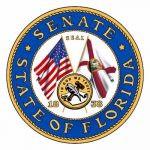SB 7068 establishes new multi-use corridors in
rural areas of regional economic significance
Senate Bill (SB) 7068, legislation to create the new Multi-use Corridors of Regional Economic Significance (M-CORES) Program within the Florida Department of Transportation (FDOT), today saw final passage in the Florida House of Representatives. Having passed the Senate on April 24, the legislation will be transmitted to Florida Governor Ron DeSantis in the coming days. The M-CORES Program, a priority of Senate President Bill Galvano (R-Bradenton), is designed to advance the planning and design of three regional corridors that will accommodate multiple modes of transportation and various infrastructure improvements including broadband and sewer access, among others.
“I am grateful to Speaker Oliva, Representative Trumbull, and our House colleagues for their consideration of and support for this historic legislation,” said President Galvano. “These new infrastructure corridors will help Florida strategically plan for future population growth, revitalize rural communities, and enhance public safety, while at the same time protecting Florida’s unique natural resources and habitats. We look forward to sending this innovative approach to infrastructure to Governor DeSantis for his consideration.”
SB 7068 identifies the following three corridors comprising the M-CORES Program:
- Southwest-Central Florida Connector (Collier County to Polk County);
- Suncoast Connector (Citrus County to Jefferson County);
- Northern Turnpike Connector (northern terminus of the Florida Turnpike northwest to the Suncoast Parkway).
The bill requires that decisions regarding corridor configuration, project alignment, and interchange locations be determined in accordance with the FDOT’s rules, policies, and procedures. The legislation requires FDOT to convene a taskforce for each of the three corridors made up of representatives of appropriate state agencies, water management districts, local governments, Metropolitan Planning Organizations, and Regional Planning Councils as well as several conservation, community and environmental organizations.
Each task force will consult with FDOT on corridor analysis, including accommodating multiple types of infrastructure in the corridor. This includes evaluation of corridor need, economic and environmental impacts, hurricane evacuation needs, and land use impacts. The bill requires public hearings in each local government jurisdiction to ensure local communities have a significant and meaningful opportunity for input.
Each corridor task force will also consider and recommend innovative concepts to combine right-of-way acquisition with the acquisition of lands or easements to facilitate environmental mitigation, or ecosystem, wildlife habitat, or water quality protection or restoration, while balancing to the greatest extent practical that the corridor configurations, project alignment, and interchange locations are not located within conservation lands acquired under the Florida Preservation 2000 Act and the Florida Forever Program. The legislation also requires each corridor task force to evaluate wildlife crossing design features to protect panther and other critical wildlife habitat corridor connections, and to evaluate design features and the need for acquisition of state conservation lands that mitigate impacts to wildlife, water quality, and agricultural land uses. Project construction cannot be funded until a report is completed.
SB 7068 authorizes additional funding for the Small County Road Assistance Program, the Small County Outreach Program, and the Transportation Disadvantaged Trust Fund.
The bill also creates and provides funding for a Construction Workforce Development Program within the FDOT. Building on the FDOT’s current workforce development services, the program is intended to serve as a tool for addressing the existing construction labor shortage by training individuals in skills necessary to deliver projects in the FDOT five-year work program, including multi-use corridor projects, on time and within budget.
To the maximum extent feasible, construction of the projects must begin no later than December 31, 2022, and be open to traffic no later than December 31, 2030.

